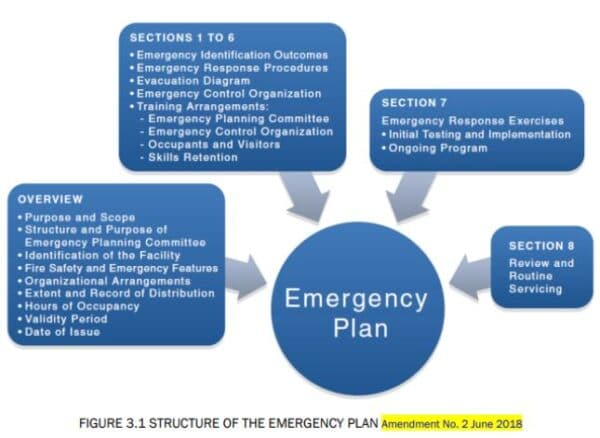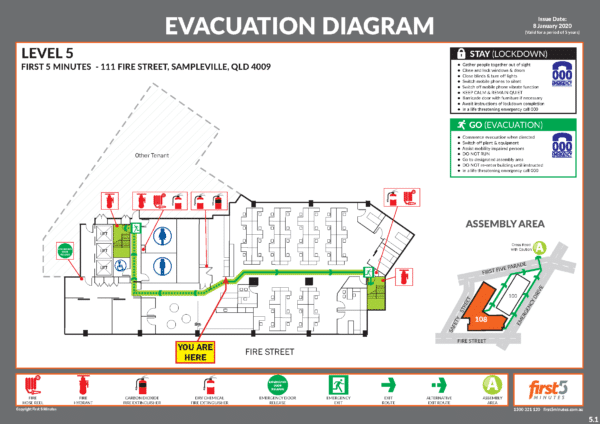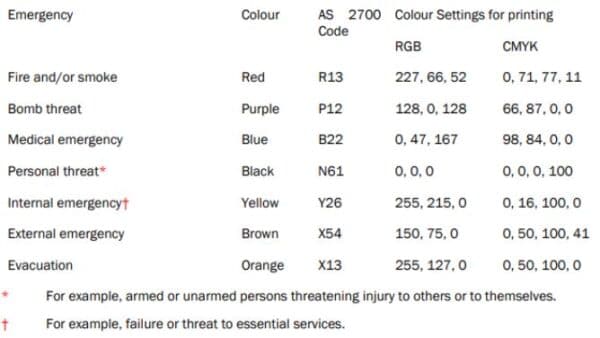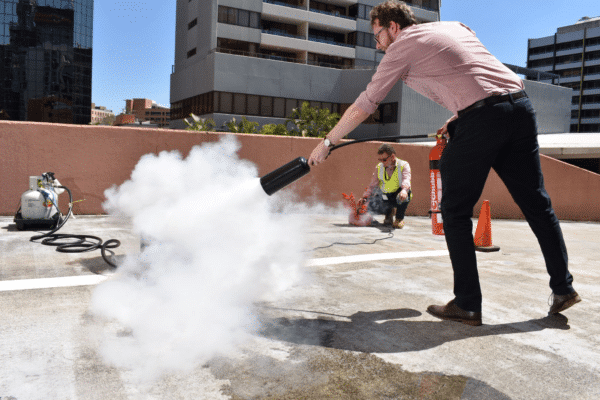Emergency Compliance: The Fundamental Guide
To be emergency compliant, means to be prepared for the effective and efficient management of any emergency in a facility. This is generally done through the development and implementation of emergency plans and procedures, as outlined in the Australian Standard 3745:2010 – Planning for Emergencies in Facilities.
When it comes to understanding the Australian Standard and emergency compliance in general, we know that it can be extremely confusing due to the large amount of information that surrounds the topic.
In this master guide, we breakdown every part of emergency compliance to provide you with the fundamental guide to understanding exactly what you need to do to maintain your compliance in every scenario.
Table of Contents
1. Why is emergency compliance legally necessary?
2. Definitions
3. Emergency Planning Committee
5. Emergency Evacuation Diagram
6. Emergency Response Procedures
7. Emergency Control Organisation
8. Training
9. Emergency Response Exercises
10. Review & Routine Servicing
Why is emergency compliance legally necessary?
Is maintaining AS3745-2010 compliance, legally required? We break down exactly how emergency compliance is highly recommended for legal reasons.
To start, it is important to acknowledge that facility managers and employers have specific legally binding duties and obligations under the Occupational Health & Safety Act 2004; to look after and provide a safe and appropriate environment for occupants.
To be able to demonstrate and identify the measures that facilities must put in place to abide by these acts, AS3745-2010 was created to outline the best practices to be compliant.
It is highly recommended AS3745-2010 be adopted within facilities to meet their obligations in the delivery of Fire Safety practices to ensure that the safety of occupants is paramount.
A facility may decide to not follow the standard; however, they must still demonstrate in those instances what they have done to abide by the requirements in the act. Therefore, it is highly recommended that facilities follow the guidelines set out in AS3745:2010.
Definitions:
To assist with reading this guide, we have prepared a few definitions for terms that you may not be familiar with:
Assembly areas:
The designated place or places where occupants must assemble during an evacuation.
Bomb
A device which can be of any size or shape, either obvious or camouflaged, may vary in sophistication and may or may not necessarily explode. Non-exploding bombs include incendiaries, toxic substance release, sharps, and animals/reptiles. Bombs can also be referred to as an Improvised Explosive Device (IED)
Bomb Threat
A threat which can be:
- Written or verbal.
- Delivered digitally, orally, in written form or other medium.
- Threatens to place or use an explosive, chemical, biological, or radiological device.
- Specifies a time, date, place, or person which it will be used on.
Class 1A Buildings
These building are classified as a single dwelling building being either:
- A detached house
- One of a group of 2 or more attached dwellings, where each is a building that is separated by a fire-resistant wall, including:
- Row house
- Terrace house
- Town house
- Villa house
Competent Person
Any individual who has acquired through training, education, qualification, experience, or any combination of the former, the knowledge and skills to correctly perform a required task.
Emergency
Emergency in this context is described as an event arising from either internal or external sources, which has the potential to adversely affect the occupants or visitors in a site or facility. Emergencies require an immediate response when they occur. If an immediate response is not required, it is not defined as an emergency.
Emergency Control Organisation (ECO)
A person(s) appointed by the Emergency Planning Committee (EPC) to direct and control the implementation of the facilities emergency response procedures. These individuals are assigned with warden duties.
Emergency Mitigation
Measures taken to decrease the likelihood of emergencies occurring, as well as any associated impacts from the emergency on occupants, the facility, or the environment.
Emergency Plan
The written documentation of the emergency arrangements for a facility, which is generally made during the planning process by the Emergency Planning Committee.
The Emergency Plan consists of:
- Preparedness
- Prevention
- Response activities
- Emergency roles
- Responsibilities
- Strategies
- Systems
- Arrangements
Emergency Planning Committee (EPC)
The persons who are responsible for the documentation and maintenance of a facility’s emergency plan.
Emergency Planning Consultant
An individual who has acquired the skill to enable them to advise on human behaviour, fire safety systems, evacuation methodology, emergency preparedness and response, and the development of an emergency plan.
Emergency Preparedness
The arrangements that have been made to ensure that if an emergency were to occur, all the resources and services required to cope with the emergency can be efficiently deployed ensuring occupant and facility safety.
Emergency Prevention
Measures which are taken to reduce the chance that an emergency will occur. These measures include:
- Policies and procedures
- Regular maintenance and servicing of appliances
- Alarm systems
- Plant and equipment
- Training
Emergency Response Exercise
A site-specific exercise implemented to determine the effectiveness of emergency response procedures.
Emergency Response Procedures
The documentation containing all assigned responsibilities, actions and procedures within the emergency plan, to respond and manage emergencies.
Emergency Service(s)
The State or Territory responsible for emergency response or recovery.
Emergency Response Team (ERT)
Specialists deployed to contain, control, or eliminate the emergency using emergency response equipment.
Evacuation
The orderly movement of occupants from a place of danger i.e. when an emergency has occurred.
Evacuation Diagram
A diagram which contains the emergency, evacuation and emergency response information about a facility, including a representation of a floor or area in pictorial form.
Evacuation Exercise
An emergency response exercise which is intended to simulate an evacuation from an emergency.
Facility
Any building, structure or workplace that can occupy people.
Facility Operational Incidents
Non-life-threatening events which likely do not require the activation of the ECO. These are not considered emergencies.
First-attack Firefighting Equipment
Equipment used to fight fires in their early stages, fire extinguishers, fire hose reels and fire blankets.
First-response Emergency Equipment
Equipment use to tackle various emergencies in their early stages; Automatic External Defibrillators (AEDs), Spill Kits, First Aid Kits.
Occupant
A person who is within a facility on a permanent or temporary basis. Examples include employees, contractors, students, or residents. Visitors are not classified as occupants.
Occupant Warning Equipment
Any systems or devices that operate to alert people within a facility of an emergency.
Personal Emergency Evacuation Plan (PEEP)
An individual emergency plan designed for an occupant with a disability who may need assistance during an emergency.
Refuge
An area on a floor of a facility designed to protect occupants from heat, smoke or toxic gases whilst also providing direct access to an exit.
Staging Area
The area in a facility where occupants and visitors are intended to gather in preparation for an evacuation.
Warden Intercommunication Point (WIP)
The location in a facility which contains a handset where instructions can be received from the emergency intercom system.
Emergency Planning Committee
What is an Emergency Planning Committee?
The Emergency Planning Committee is a group of individuals who are responsible for the development, implementation and maintenance of the emergency plan, emergency response procedures and related training of a facility and its occupants. These responsibilities may be undertaken in conjunction with external organisations.
What is the Emergency Planning Committee (EPC) in charge of?
The EPC is primarily in charge of the overall Emergency Plan and therefore the overall safety of occupants in a facility during emergencies. There are a multitude of responsibilities that the EPC must also take charge of:
- Identify events that could reasonably produce emergency situations.
- Develop the emergency plan for a facility.
- Ensure resources are provided to assist with the implementation and development of the emergency plan.
- Determine when the emergency plan must be updated, which cannot be longer than 5 years.
- Ensure the emergency plan is easily accessible to occupants of the facility.
- Establish the Emergency Control Organisation following the emergency plan, and if necessary, establishing the Emergency Response Team (ERT).
- Authorise the release of the emergency plan across the facility. Authorisation requires:
- Spreading awareness about the plan
- Training provided to the ECO.
- Testing emergency procedures, including emergency evacuation procedures.
- Reviewing procedures after they’ve been tested.
- Ensure that the register of ECO members is kept up to date.
- Develop strategies to ensure visitors are aware of emergency response procedures.
- Test emergency response procedures at minimum annually, to ensure that they remain viable for the facility and occupants.
- Ensure the emergency plan is reviewed before the validity period is complete, any changes are made to the facility, or emergency exercises are performed.
- Maintain records of events for each emergency that occurs within the facility, which is compiled and retained.
- Identify gaps and deficiencies in the emergency plan, emergency response procedures, and offer opportunities for improvements.
Who is allowed to be a member of the Emergency Planning Committee?
When it comes to members of the Emergency Planning Committee, it can be confusing as to who can be a member and who cannot.
First, the Emergency Planning Committee must consist of at least 2 individuals, who are representative of the stakeholders in a facility. One representative must be that of management. If the facility is owned and operated by a single individual, then the EPC may consist of that single individual. Contractors are not allowed to be EPC members, however they may attend meetings when deemed appropriate.
On top of the above requirements, at least one member of the EPC must be classified as a competent person as defined in the Australian Standard 3745:2010. As an example, most EPCs will consist of senior management, tenants, chief wardens and specialist facility personnel and an occupant with a disability if reasonably available.
How often must the Emergency Planning Committee meet?
At a minimum the EPC must meet annually. However, this is only a minimum requirement, and the EPC will likely meet more than once per annum to discuss their responsibilities. Every meeting which the EPC conducts must be recorded in accordance with legislative requirements.
Emergency Plan
What is an Emergency Plan?
The Emergency Plan is the master document which contains the organisational arrangements, systems, strategies, and procedures relating to the response and management of emergencies in a facility. This document is created by the Emergency Planning Committee who determine which types of emergencies require specific emergency response procedures in the emergency plan.
Generally, the emergency plan is written up in collaboration with facility owners, managers, occupiers, and employers alongside the EPC.
At a minimum, the emergency plan must contain:
- Emergency prevention
- Emergency preparedness
- Emergency mitigation
- Activities to prepare and prevent emergencies
- Overall arrangements for emergency response, including evacuation strategies
- The agreed roles of the Emergency Control Organisation and the occupants within the facility during and after an emergency.
How is the Emergency Plan structured?
Including the above, the Emergency Plan must include but is not limited to the following structure:
- A statement of purpose and scope.
- Information on the structure and purpose of the Emergency Planning Committee.
- Identify the facilities it applies.
- Descriptions of the emergency features of the facility.
- Organisational arrangements of the facility.
- Emergency identification outcomes.
- Evacuation diagrams.
- Training arrangements.
- Review and routine servicing.
- A statement of the extent the emergency plan will be distributed.
- A record for the emergency plans distribution, including where PEEPs are being held.
- The hours of occupancy of the facility. Note: this goes beyond the open hours of a facility, but rather the entire duration occupants are expected in the building.
- The validity period of the emergency plan.
- The date of issue and any amendment dates.
By covering all the above, the emergency plan is able to provide the ECO and occupants with the details they require to remain safe during emergencies. You can learn more about the emergency plan in our detailed blog post here.
Evacuation Diagrams
What is an emergency evacuation diagram?
Emergency evacuation diagrams contain the emergency evacuation and emergency response information about a facility, including a representation of a floor or area in pictorial form. For more in-depth information related to compliant evacuation diagrams, read our detailed guide.
Emergency Response Procedures
What is an Emergency Response Procedure?
An emergency response procedure refers to the documentation containing all assigned responsibilities, actions and procedures within the emergency plan, to respond and manage emergencies. It is imperative that an emergency response procedure is created for each identified potential emergency for a facility.
It is imperative that emergency response procedures cover the following:
- Responsibilities and actions of the ECO during an emergency.
- Arrangements for the emergency preparedness and response.
- Arrangements for evacuating the facility.
- Emergency contact details.
The specific information that is included in the emergency response procedures shall be determined by the EPC in collaboration with facility owners, managers, occupiers, and employers.
The key considerations which the EPC may consider adding to Emergency Response Procedures include:
- After hours procedures for people who may be present outside the normal hours of business/operation.
- The methods of warning and communication used during emergencies, including communicating to occupants with potential disability.
- Communication methods with neighbouring facilities
- If multi-modal communication systems will be used for emergency responses. E.g. Emergency Warning and Intercommunication System (EWIS), visual/tactile signals, telephones, two-way radio, or paging systems.
- Any limitations of communicating with certain equipment during certain emergencies.
- If any communication equipment could pose as a threat to worsen emergencies involving explosive devices.
- How batteries will be charged for battery requiring equipment.
- The potential for equipment failure.
- The appropriate location for where the Chief Warden can establish control, communication, and coordination, and liaise with Emergency Services.
- Finally, instructions on the use of first-attack firefighting equipment and first-response emergency equipment.
Are evacuations part of Emergency Response Procedures?
Emergency Response Procedures must also include the actions that will be taken by your occupants and ECO to evacuate the facility if the emergency is appropriate.
If any occupants of your facility have a disability, separate evacuation arrangements must be considered when developing the evacuation emergency response procedures. This is due to disabled occupants being potentially unable to evacuate through certain egress routes.
There are 3 main evacuation options that can be used depending on the emergency type:
- Full Evacuation – A full evacuation is used to clear a building or facility of all occupants. This evacuation is generally carried out in response to potentially catastrophic and life-threatening situations that affect the entire building.
- Partial Evacuation – An alternative to the full evacuation, where only a portion of occupants are evacuated from a facility. This measure is generally used where the danger to occupants is localised to only one area of the facility, and evacuation of only key areas is enough to ensure occupant safety.
- Shelter In Place – There are certain emergencies where no evacuation is the best method to ensure occupant safety. Emergencies where this measure is most appropriate include earthquakes, lightning storms, floods, dust from adjacent structures, air-borne toxic agents, and dangerous animals. For this option to be viable, an assessment of the shelter/refuge/facility must be conducted to determine its suitability to protect occupants.
During evacuation procedures, it is important that the EPC take into consideration exactly how the procedure will affect evacuation routes and normal paths. Determining appropriate strategies to make sure all occupants can evacuate safely through pre-planned routes is extremely important. This includes the use of lifts and escalators, which generally are not relied upon as a means of evacuation unless approved by a regulatory approval process.
As occupants leave the facility, they must be instructed to travel to a pre-determined Assembly Area.
Assembly Areas must be sufficiently distant from the emergency to ensure occupant safety, as well as:
- Allow for further movement away from the emergency.
- Sheltered from the affected facility.
- Accessible by suitable routes for all occupants.
- Safe for large numbers of people to occupy.
What else should be considered during evacuations?
In addition to the above points, there are numerous considerations that the EPC should take when developing emergency evacuation response procedures including:
- The duties of wardens and first aid officers.
- How media responses will be delivered after an emergency.
- The best way to evacuate visitors or other persons who may be unfamiliar with the evacuation procedure.
- Process for dealing with effects of occupants.
- If any refuges will be made use of, which are areas occupants and visitors may wait in for a delayed independent evacuation.
- The use and storage of stairway evacuation devices, generally for occupants with disabilities who require help.
- How vehicular movement will potentially impede evacuation routes once outside the facility.
How do occupants know which emergency is taking place?
To effectively communicate the type of emergency which is occurring and therefore activate the proper response procedure, a standardised colour code system is used. The list of colour codes can be seen in the table below:
Once the emergency event has been cleared, it is imperative to let occupants know through verbal notification. The words “(Colour Code) All Clear” must be used.
Emergency Control Organisation (ECO)
The ECO are a group of individuals assigned by the EPC, who are responsible for certain roles during emergencies to ensure occupant safety. Generally, titles used for members of the ECO include:
- Chief Warden
- Deputy Chief Warden
- Communications Officer
- Floor/Area Warden
- Warden
- First Aid Officer
Other positions may be added to the ECO as determined by the EPC. Such examples include runners, stair wardens, or roll call wardens.
It is extremely important that an up-to-date register of all ECO members is kept readily available with the Chief Warden.
What do ECO members do?
ECO members are all assigned their own specific tasks during emergencies, dependent on the role they have been assigned.
For an in-depth guide on ECO member roles, identification and more read our fundamental guide here.
During emergencies, any instructions given by members of the ECO shall take precedence over the normal management structure, until the emergency has been confirmed over and occupant safety has been ensured.
Training
What kind of training must be conducted to be emergency compliant?
When it comes to responding safely to emergencies, it is extremely important that your facility provides training to the:
- EPC
- ECO
- Facility occupants
These training sessions are required so that each person can competently execute their roles during emergency situations.
What kind of training does the EPC receive?
EPC members must receive training that enables them to competently execute their obligations, and should address but is not necessarily limited to how to:
- Develop, manage, and maintain the emergency plan.
- Understand the duties of the EPC and ECO members during emergency response procedures.
- Outline the duties of the ERT as during emergency response procedures.
- Conduct site-specific emergency identification and analysis.
- Establish and manage an ECO.
- Manage appropriate documentation.
- Manage and develop assessment activities.
- Develop the implementation of training activities, including emergency exercise management.
- Outline emergency mitigation, emergency preparedness and emergency prevention.
- Manage installed fire safety systems including sprinklers, fire doors and installed emergency communications, notifications, and warnings.
- Liaise with Emergency Services.
- Manage post-evacuation processes.
What kind of training does the ECO receive?
All ECO members must be trained to develop the skills and knowledge necessary to perform their duties outlined in emergency response procedures. Due to ECO members potentially being absent during emergencies, all ECO positions must have more than the minimum number of members.
The training of all ECO members must include:
- Duties of the ECO as described in emergency response procedures.
- Procedures for all specific emergencies outlined in the emergency plan.
- Responding to alarms and reports in emergencies.
- Reporting emergencies and initiating the installed emergency warning equipment.
- Communication methods during emergencies.
- Pre-emergency activities.
- Post-emergency activities.
- Training on Personal Emergency Evacuation Plans.
- Human behaviour during emergencies.
- How to use installed emergency response equipment.
- How to use the facilities installations during a fire or other emergency. E.g. fire doors, emergency lights, or sprinklers.
All the above training must also contain an assessment component on top of the training, to ensure that ECO members have paid the appropriate amount of attention during training. To ensure the retention of training information, all ECO members must attend skills retention training at intervals no greater than 6 months apart.
What kind of training do Chief & Deputy Chief Wardens receive?
In addition to the training that all ECO members receive, Chief & Deputy Chief Wardens must also receive training on:
- Their roles, responsibilities, and duties.
- Duties of the ERT.
- Decision-making, command, and control tactics.
- Record keeping.
- Actions for specific emergencies as outlined in emergency response procedures.
- Coordination of communication during emergencies.
- Liaising with Emergency Services.
- Coordination of evacuation activities.
- Implementation of post-emergency activities in accordance with the emergency plan.
Is first-attack firefighting training necessary during fire emergencies?
If specific occupants have been chosen by the EPC and included in emergency procedures, these occupants must be trained in first-attack firefighting to properly fulfill their duties.
This training must include:
- Duties of the ECO and ERT.
- Preparing for site-specific fires.
- Reporting fires.
- Evacuating from endangered areas.
- Correctly identifying, reporting, and correcting unsafe conditions.
- Responding to fire emergencies.
- Properly identify the class of fire.
- Selecting the correct first-attack firefighting equipment based on class of fire.
- Safe operation for first-attack firefighting equipment.
- Determining when it is safe to use first-attack firefighting equipment.
- Procedures to follow after using first-attack firefighting equipment.
- Post-evacuation activities.
To ensure the retention of training information, all First-Attack Firefighting occupants must attend skills retention training at intervals no greater than 24 months apart.
What about training for other occupants?
All occupants working at a facility must receive training to increase the success of emergency response procedures during emergencies. Not only must existing occupants receive training, but all new occupants must also receive training as they enter a facility.
The training must at a minimum include:
- Occupant responsibilities during emergencies.
- The types of emergencies outlined in the emergency plan.
- How to report emergencies contained in the emergency plan.
- Recognising and reporting unsafe conditions and correcting unsafe conditions when appropriate.
- Authorities, roles, responsibilities, and identification of ECO members.
- Reacting safely to emergencies and alarms.
- Evacuation procedures.
- Location of internal and external staging and assembly areas, as contained in the emergency plan.
- Location of egress routes.
- Post-emergency protocols.
- Procedures for specific emergencies.
Occupants of a facility, who do not work at a facility, must still receive training to enable them to act in accordance with emergency response procedures.
Visitors at the facility are not required to receive the same training, however they must be provided with the appropriate information on the emergency response facilities of the facility.
To ensure the retention of training information, all occupants must attend skills retention training at intervals no greater than 12 months apart.
What kinds of training materials are provided?
All ECO members and occupants receiving training must be supplied with appropriate training materials dependent on role and responsibilities. These materials are important to refer back to in case any training is forgotten.
Training materials can be supplied in the following forms:
- Large print
- Electronic
- Audio
- Braille
- Languages other than English
- Reference charts
Emergency Response Exercises
What are Emergency Response Exercises?
Emergency Response Exercises are a site-specific exercise implemented to determine the effectiveness of emergency response procedures both when developed and on an on-going basis. These exercises are developed by the EPC in collaborations with facility owners, managers, occupiers, and employers of the facility.
All Emergency Response Exercises must:
- Be consistent with the identified emergencies in the emergency plan.
- Identify simple objectives and outcomes for emergency response procedures.
- Appoint observers to record the details of the emergency response exercise.
- Should be prefixed by an announcement that it is an exercise only.
- Include a debrief once the exercise is over.
- Have a report recorded which is forwarded to the EPC, including any deficiencies in the exercise that were identified.
How should Emergency Response Exercises be tested?
Once Emergency Response Exercises have received the proper confirmations of their effectiveness, they should be tested within 12 months.
The first emergency response exercise that should be tested is the evacuation exercise of the facility. The exercise should be arranged for a certain time, which occupants are made aware of to ensure there are as many occupants in the facility as possible for the exercise.
If the facility is particularly large, then a partial evacuation may be undertaken to test the ECO in the first instance.
How often am I required to undertake these exercises?
After the implementation phase (i.e. first exercise is conducted), a program of site-specific emergency response exercises shall be developed for each facility. All areas of a facility shall participate in at least one emergency response exercise involving an evacuation each year.
All occupants of the floor/area involved in an emergency response shall take part, unless the EPC grants a written exemption before it is carried out.
If an actual emergency occurs during an emergency response exercise, a pre-determined word by the EPC, for example “NO DUFF”, shall be communicated to all ECO members. This phrase will signal the end of the exercise and that the ECO must standby for further instructions.
Review AND Routine Servicing
How do you ensure your Emergency Plan is current?
The EPC must ensure that the emergency plan and its associated documents are inspected, tested, and routinely serviced to remain current.
Any deficiency in the emergency plan or associated elements must be reported to management or the EPC once the inspection or testing is complete and must be rectified as soon as possible. All records of inspection, testing and routine servicing must be kept up to date.
Additionally, all communication systems must be regularly checked at monthly intervals by default, or another interval if determined by the EPC. Records must be kept outlining equipment conditions.
This fundamental guide contains most of the information that a facility manager or anyone else might need to ensure emergency compliance for their facility. As you can see, the requirements are extremely extensive however they are necessary to ensure occupant safety during emergencies.
At First 5 Minutes, we provide a comprehensive package that contains all the essentials that your facility requires to remain compliant – making it accessible and effortless to keep up your compliance.








